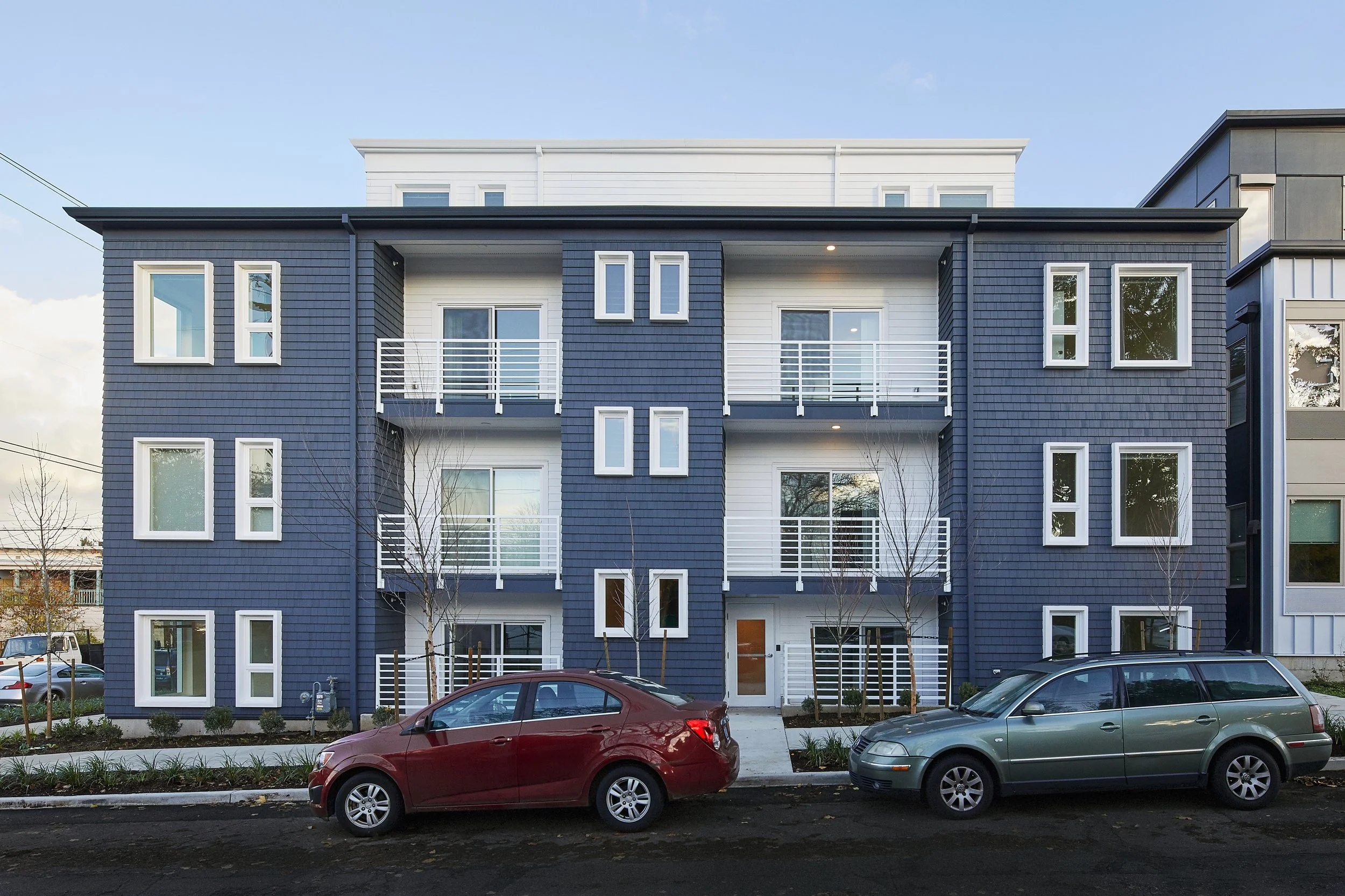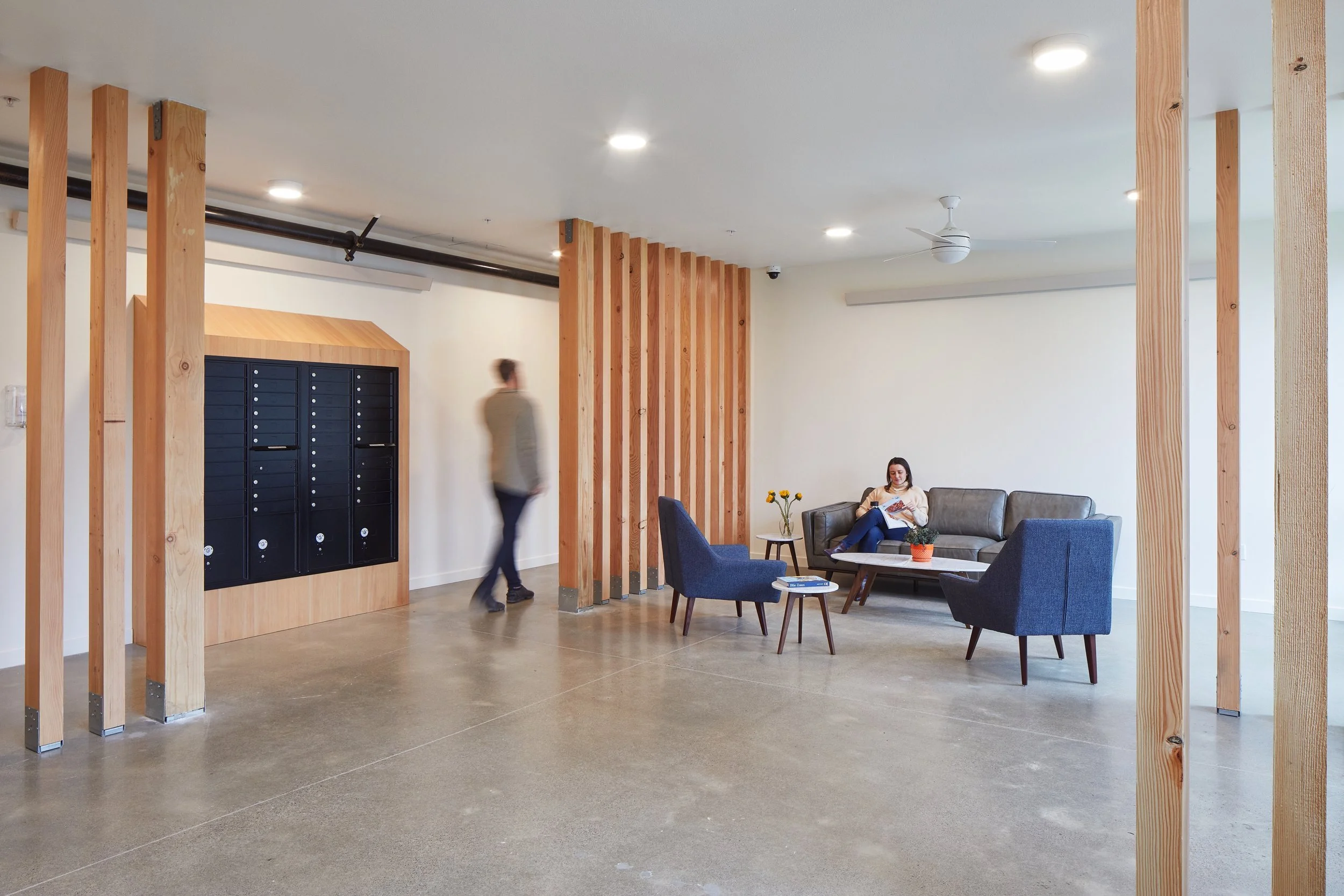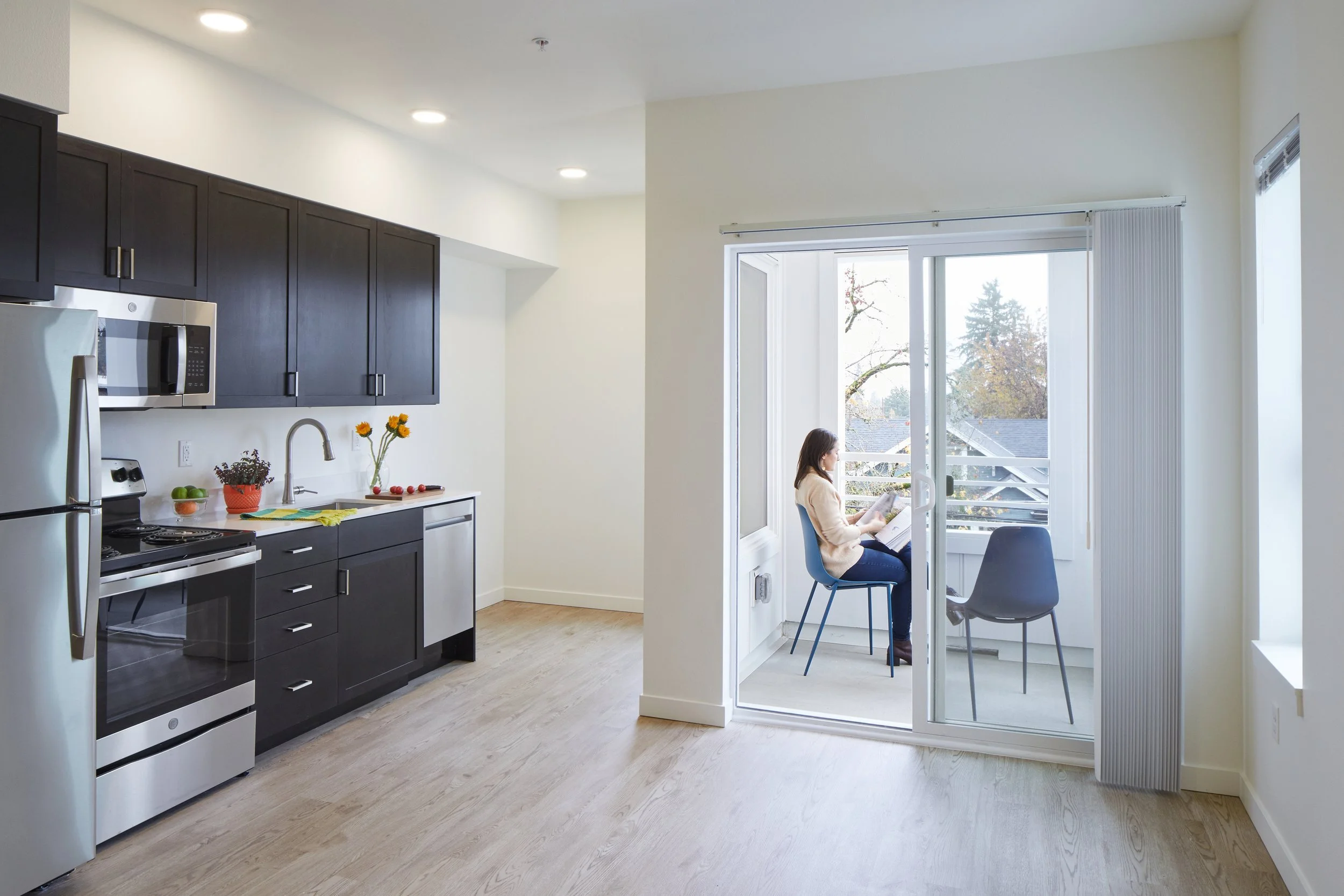330 Dekum
-
At 330 Dekum, the development team had two central goals. First, to create meaningfully affordable housing in a cost-effective way that could be replicated easily by other market rate developers, without relying upon the large federal or statewide subsidies that facilitate large scale, but expensive to develop, affordable housing projects. Second, and equally important, to provide well designed, comfortable apartments inside a modern and thoughtfully designed building that was responsive to the neighborhood context.
Situated on a modest infill lot, 330 Dekum contains 39 apartments, a mix of studio and one-bedroom units, in its 18,700 square feet, 34 of which are affordable based on the 60% area median income (AMI) threshold. The remaining five market-rate apartments are available as a way for existing tenants to remain in the building should their incomes increase beyond the AMI limit.
To keep costs lower and predictable, the team elected to design the building to Portland’s community design standards, reducing potential permitting costs and schedule risks. The team focused on a handful of key details and material selections to comply with the design standards, while elevating the design and visual interest of the project with limited cost premiums. The box metal window surrounds add a touch of sophistication to the building and the use of Nichiha shake style premium cement siding adds texture and depth to the facade. Apartments feature well-designed interiors, shared common spaces and amenities within a highly efficiently laid out building.
In addition to being a part owner, Owen Gabbert, LLC served as the project’s developer, overseeing the architect, permitting, and financing, managing the schedule and budget, and acting as the construction manager. This hands-on approach allowed the team to stick to (and even beat) the strict budget despite unforeseen challenges resulting from the COVID-19 pandemic, which hit mid-project. The building serves as a model for how affordable housing can be thoughtfully and beautifully developed without large subsidies and provides a much-needed resource in a growing city.
Preserving as much of the former structure as possible for both budgetary and environmental reasons, the Owen Gabbert, LLC team transformed the building and outdoor space into a welcoming and casual neighborhood dining spot. The team strived to reestablish the building as something totally different while capturing as much value from existing conditions as possible. An adaptive reuse project, the footprint mostly stayed the same while the existing building was entirely reconfigured.
The client, an avid traveler and neighborhood resident, wanted Hinterland to activate the site and serve as a hub for the best food carts in town. To draw those carts, individually metered electrical, gas, and water connections were provided along with a shared underground grease trap, trash enclosure, and dishpit inside the building.
Working alongside Design Department Architecture + Interiors, the Owen Gabbert, LLC team vaulted the ceiling to open up the space, added custom wainscoting, and installed a bar and tables made from reclaimed lumber salvaged from another of the owner’s properties. They also created a large ordering window—inspired by social distancing measures put into place during construction—which now serves as the center point of the whole complex. Timber frame front and back porches, also made from salvaged lumber, offer ample covered outdoor seating and a comfortable destination to enjoy a wide selection of food and handcrafted drinks.
Owen Gabbert, LLC served as general contractor on the project, and also provided its expertise as a development consultant by creating preliminary feasibility studies, identifying financing options, and managing consultants. The project was highly collaborative with the client, contractor, and architect working closely together to achieve the best result possible within the constraints of budget and site.
Since it opened in January 2022, Hinterlands has been considered one of the top 5 food cart pods in the city and was named the #1 food cart pod that year by Oregon Live. Situated near Mount Tabor, the location is easily accessible by foot, bike, and bus.Located at NE Prescott and 29th, the 1922 Prescott Fountain Building had seen many lives throughout the years, including an antiques store, soda fountain, barber shop, and more before its most recent iteration as a corner convenience store. The 7,000 square foot structure had been divided into three uses—the convenience store, an empty retail space, and a small residential unit—and required a sizable renovation to meet Evolve’s needs and vision. The team replaced the roof, added new insulation throughout the building, replaced the entire mechanical system, and conducted a partial seismic upgrade.
In addition to finding the building, Owen Gabbert, LLC, provided their expertise throughout the acquisition process by assembling the pro forma and development budget, completing outreach to and coordinating with banks to identify a financing partner, and providing feedback about the overall feasibility of the project, including consideration of the permitting and constructability requirements. They also helped select the architect for the project, Beebe Skidmore, who had successfully completed similar work in Portland.
The agency wanted an open floor plan concept with defined areas for their offices, a space to hold events, and a tool room and workshop for their product design work. To open up the existing space, the team entirely reconfigured the interiors and façade. They captured additional height by removing the existing ceiling to expose the original site-built wood trusses. To create visual appeal and bring light into the interior space, they installed three modern rooftop pop-outs with large windows, skylights, and double-hung windows at the street front. The team also installed large roll-up doors that open up the office and event spaces.
Having met and collaborated with OGLLC on several small projects prior, Empire Green reached out in 2019 for assistance with evaluating possible buildings to acquire and occupy. After touring several buildings that failed to meet their programmatic and pricing needs, Empire Green began to contemplate purchasing a residential property, as it would be more aligned with the size and cost they had in mind. Concurrently, OGLLC was about to be displaced from its office as it redeveloped that property into a new coliving community.
Recognizing an opportunity to share resources and expand the pool of possible properties, Owen proposed that they look for space to share. In addition to expanding the realm of options to larger properties, a shared office would reduce each group’s construction and rent expense through shared resources like common exterior spaces, circulation, and conference rooms, as well as provide downstream flexibility to grow and contract together.
In addition to being one of the two Clients/Owners, Owen Gabbert, LLC, managed or self-performed every step of the process as the Developer and General Contractor on the project. This included identifying a lot in the preferred Boise neighborhood in North Portland and brokering the off-market transaction with an acquaintance who owned the lot through property management of the existing triplex. One significant challenge was that the preservation of the existing triplex reduced the buildable area to the back half of the lot and created constructability challenges that necessitated the complete construction and tipping up of the 20’ high first floor north wall on the ground. However, the retention of the income-producing property provided financial flexibility to reduce the time pressures faced by many developments and elevate the design quality to a level that reflects the values of both businesses.
To deliver the desired quality and to adeptly work within the site constraints in a creative, responsive way, OGLLC selected Beebe Skidmore as the architect. They had worked on many projects together previously, including the construction of the architecture firm’s own office, and knew that their focus on collaboration and creativity would be key to the success of this infill project.
The resulting 4,000-square-foot building is a 2-story open office space with a mezzanine on each floor and breakout spaces for meetings. There is a large, shared conference room on the 1st floor, a smaller conference room on the 2nd-floor mezzanine, a kitchenette on each of the two floors, and three bathrooms, including one with a shower. Each of the two floors has soft seating to serve as gathering or informal meeting spaces or just a spot to relax. Outside, on the ground floor there is a shared courtyard at the entry with seating and a terrace at the first-floor mezzanine level.
One of the focal points of the office is the staircase that serves as a throughline from the ground floor to the top floor of the space. The stairs are perforated metal with punched holes for transparency, while the sides are clad in plywood that match the ceiling, cabinetry, and mezzanine floor. The staircase sits in front of a checkerboard of large windows, so natural light enters the space from the top floor all the way down to the main entry. The building uses simple materials throughout—exposed wood structures, a concrete slab for the 2nd floor, simple white walls, and generous pine windows—for an appealing natural look.
To make the scale and texture of the building relate to the residential surroundings, the exterior is a 1x6 shiplap Shou Sugi Ban, burned cedar siding harvested and manufactured by a local business, Nakamoto Forestry. The ancient Japanese architectural technique is low-maintenance and is used to preserve wood by charring the surface with a hot flame. The building’s muted black color allows it to fit in beautifully on its site, while literally and figuratively fading to the back of the lot.
-
Architect: Brett Schulz
General Contractor: TEAM Construction
Developer: Owen Gabbert, LLC
Civil Engineer: Froelich Engineers
Structural Engineer : TM Rippey
Owner: Songbird Development, LLC
Photographer: Sally Painter Photography





